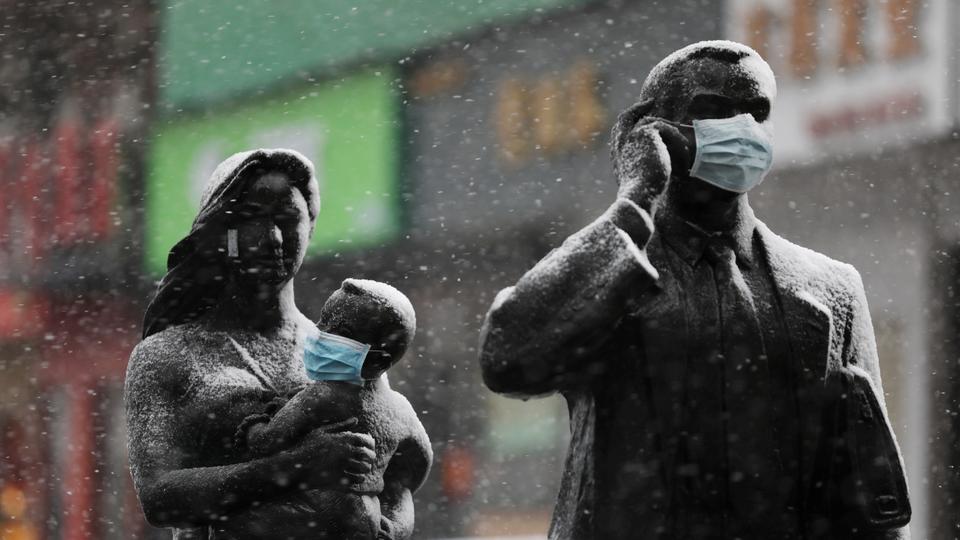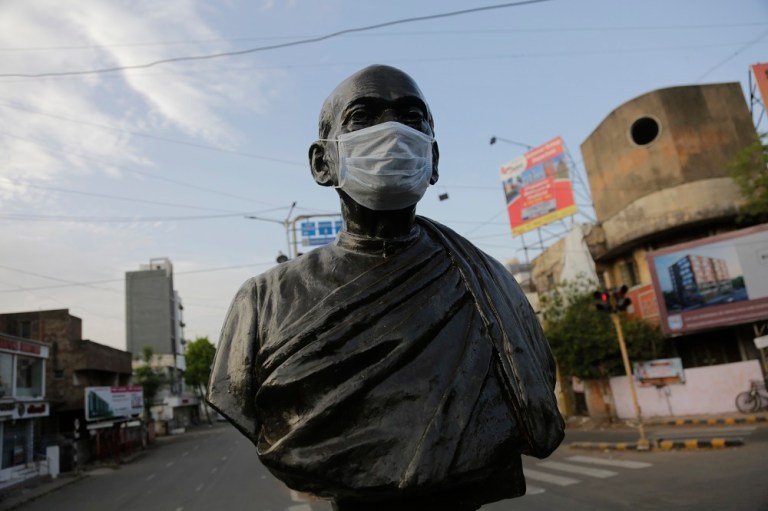Around the world, as many suffer and others brace themselves for the profound impacts of the COVID-19 pandemic, cities and towns rapidly empty their public spaces to halt the spread of the virus.
Public squares, landmarks, museums, libraries, and other civic gathering spaces that represent and foster our interconnectedness, are cordoned off and shut down. Through technology, we attempt to reconfigure some of these institutions and sites in the virtual realm. But across the board, we are compelled to withdraw from many of our most vital points of engagement and connection for the foreseeable future.
As we transition our routine modes of living together, urgently adapting our lives through social distancing and self-quarantine, our monuments that are left behind continue to speak out.
Statues adorned with face masks are parting gifts for our public spaces.
From Wuhan to Valencia, New York City to Limerick, these icons are appearing at times when residents are forced to withdraw and contend with the crisis. Surgical masked statues are popping up, often without attribution, drawing on the power of public art and the internet to speak loudly without words, to caution and create connections in the midst of a pandemic.

Whether playful or subversive, pranks or political statements, this constellation of global masked monuments points to the failure of systems to act fast enough. As some elected officials are castigated for looking away, others respond with unprecedented measures. Meanwhile, everyday residents perform their own acts of courage to mark this moment and drive home the sense of urgency.
In San Fiorano, Italy, one of the towns in Lombardy locked down in the throes of the pandemic, a weathered plaster statue of St. Francis of Assisi, the patron saint of the country and ecology, dons a face mask that reads “Made in Italy.” Local school teacher Marzio Toniolo shared a now-viral photograph of this scene while documenting life in his town’s “Red Zone.”
In Sofia, Bulgaria, upon increasing travel restrictions and outbreaks of new COVID-19 cases, photographer Ivan Shishiev placed face masks on statues across the city with “COVID-19” scrawled on them to confront panic and fear directed against fellow residents, reaching over 100,000 viewers online in a matter of hours, according to Bored Panda.
This is not the first time in recent years that people have placed face masks on their civic monuments to send direct messages to the living. In 2016, environmental activists affixed gas masks on the faces of historic statues to Queen Victoria and Winston Churchill to call attention to the dangers of air pollution. Last year, activists in Beijing installed similar interventions on statues in the city against the destructive impact of smog on residents’ daily lives and the environment.
More broadly, such unauthorized monumental engagements with public symbols are acts of speaking truth to power. Past examples include red paint on the hands of conquistadors to anti-racist graffiti spraypainted on memorials to Confederate generals. In other cases, when local residents tear down an unjust monument or seek to build new ones to underrepresented figures, they take on the power and limits of representation in public space.
In addition, there are other forms of contact that also constitute personal acts of care. People enliven statues through embrace, leaving offerings of food, flowers, and winter clothing during colder months. Such interactions demonstrate that by engaging directly with their monuments – not just treating them as disconnected, static symbols – residents define their evolving relationships to themselves and to the world around them.
Whether larger than life or enshrined at eye level, monuments have an aura of permanence while maintaining an uncanny sense of human vulnerability. When we interact with them, they become useful proxies for political reckoning and social support.

Of all the places to advocate for greater forms of connection despite our imperatives for social distancing, artists and activists who place face masks on historic statues turn to landmarks that are older than us and thus embody a spirit of endurance.
These public artifacts are meaningful platforms to grasp our present condition. Such gestures also remind us that even in this extreme moment, human suffering doesn’t begin or end with COVID-19. And neither does a drive for compassion in the face of a routinely socially divided, yet physically-connected world.
In a time of withdrawal from the physical public sphere, these masked monuments are more than simple reminders to take appropriate measures that ensure public health and safety for one’s individual physical body. They are provocations to protect and uplift the civic body. A new symbol for our intense times, these interventions are intentional acts of care and critical calls to action.
